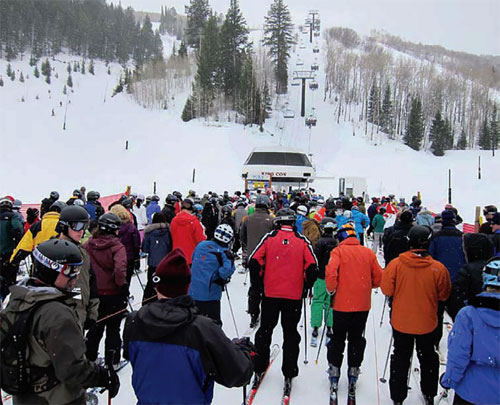Utah’s ski industry experienced a record season in 2016-17, with nearly 4.6 million skier days.
The 4,584,658 skier days topped the previous record of 4,457,575 during the 2015-16 season, according to Ski Utah. The eight-month season — Snowbird stopped its lifts June 11, making the season 197 days long — saw the number of skier days rise 8.35 percent over Utah’s five-year average of 4,231,276.
A skier-day is defined as one person visiting a ski area for all or any part of a day or night for the purpose of skiing/snowboarding. The lowest skier-day total in Utah during the past 10 years was 3,825,090 in 2011-12.
“Mother Nature plays a huge part in our industry — our No. 1 marketing partner,” Nathan Rafferty, Ski Utah president, said at a news conference last week. “I remember standing back here in November earlier this year, and it’s always a highly anticipated time of year where we’re wondering is it going to snow, is it not going to snow? Mother Nature did come through for us this year, absolutely.”
Ski Utah said snowfall had a slow start but saw season totals “up significantly.” Brighton Resort in Big Cottonwood Canyon reported 632 inches, with more than 200 inches in January alone.
“Snow is great. A lot of snow is great,” Rafferty said. “But it’s important when it comes, and it came early and often for us this year. And having it in January, getting us set up for a big February and March time period, was awesome. … The snow, while it started a little bit later than we would have liked — it probably cut out a couple of weeks of our ski season on the front end — but it did come, and it came hard and fast.”
Utah officials were optimistic for a big season, with the reasons including coming off a record year in 2015-16 and an all-time high in funding for the Utah Office of Tourism.
Nationally, the number of skier days rose to 54.7 million, a 3.7 percent increase from the prior season’s 52.8 million. Strong figures were recorded in the Northeast, Southeast and Pacific Northwest. Declines were seen in the Pacific Southwest, Rocky Mountains and Midwest. Utah was an outlier in the Rocky Mountain region, which saw a 3 percent drop, compared with Utah’s increase of 2.85 percent.
The increase in skier days resulted in a bigger economic impact in Utah, to $1.43 billion in the past season. That compares with $1.17 billion in 2014-15. Per-skier-visit expenditures, checked every other year, rose to $296 during the past season, topping the $276 mark in 2014-15.
“We saw not only an increase in the volume of skiers but an increase in per-skier spending — both good things,” Rafferty said.
“Tourism has emerged as one of the key drivers in Utah’s diverse economy,” said Vicki Varela, managing director of tourism, film and global branding for the state. Travelers in Utah spent $8.17 billion in 2015 and contributed $1.15 billion in total state and local taxes. “State sales tax revenue generated by travelers helps fund a variety of Utah priorities, including education, public safety, health and human services, road construction and maintenance.”








